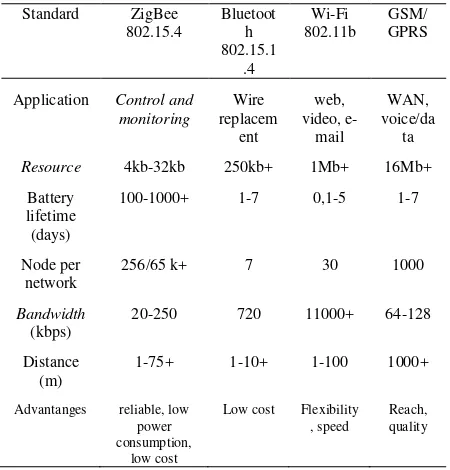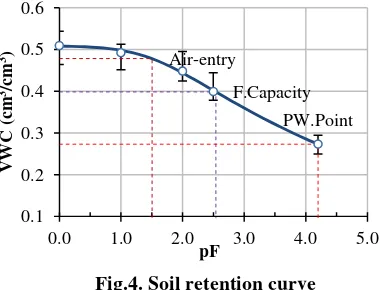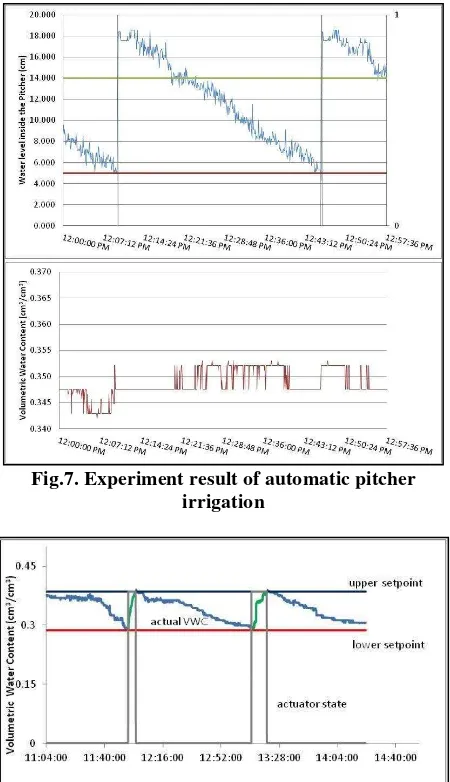Development of Automated Irrigation System for Food Production
Land
Satyanto K. Saptomo Budi I. Setiawan
Abstract As respond to demand on reducing water for agricultural sector as the water usage competition is increasing between various sectors, water efficient irrigation techniques were offer in order to keep the water status at the desirable level at a production land, while avoiding loss of water and within a certain amount of water available. Automation system was applied to micro irrigation system following wireless control network concept for multiple outdoor plots with different types of irrigation system. Control system is applied for tickle, sprinkle, pitcher and disk irrigation. The automated irrigation system is proven to work and keep water status accordingly to the desired condition which is field capacity, between pF 2.54 and 4.2. As the soil moisture was kept within the range percolation can be suppressed to its minimum or even halt. The system can be improved and used for various conditions of production lands and irrigation infrastructure.
Keywords : e-water management, irrigation engineering, automatic control system, agriculture, water productivity
Satyanto K. Saptomo ()
Department of Civil and Environmental Engineering Bogor Agricultural University
IPB Campus Darmaga, 16680 Bogor, Indonesia email: [email protected]
phone/fax : +62-251-8267225 Budi I. Setiawan
Department of Civil and Environmental Engineering Bogor Agricultural University
IPB Campus Darmaga, 16680 Bogor, Indonesia
Introduction
At present, there is a demand for the agricultural sector can reduce water usage as the competition is increasing in water use in various sectors like power generation, domestic and industrial sectors. As respond to this situation, there are many water efficient irrigation or cultivation techniques that had been offered. The task is to keep the water status at the desirable level at a production land, while avoiding loss of water and within a certain amount of water available.
Uncertainties about the impacts of climate to water availability have also been a challenge to agriculture water management. One effort to adapt to this situation is by increasing water use efficiency, or further the water productivity.
Nowadays, digital electronic and information technology had been accepted widely in most aspect of living. The term e-mail or even e-government had been used to represent mail exchange and governance that extensively use, if not totally, electronic and information technology. Similarly, water management can also use the term e-water management or e-water resources management to emphasize the use of the modern technology. This includes the use of electronic sensors and devices that integrated into a system so that acquired information can be seamlessly directed to whom it may concerns.
Automated irrigation system is one of the technologies that can be used to increase the efficiency of water utilization by preserving exact water status to the field as desired. This is hopefully can contribute to improve performance of irrigation water management. Automatic system commonly works depending on sensing and control mechanism, which can vary from simple mechanics to very sophisticated sensors and digital controller.
This paper aims to present the development of automated irrigation system following wireless control network concept for multiple outdoor plots with different types of irrigation system to increase water use efficiency.
Automated Irrigation System Development
Control System
Process control is the automatic control of an output variable by sensing the amplitude of the output parameter from the process and comparing it to the desired level and feeding an error signal back to control an input variable. Changes in parameter during a process will be converted to an electrical signal, amplified, and sent to a controller that evaluates the signal and sends a correction signal to an actuator. The actuator adjusts the parameter at its predetermined values.
Fig 1 Close Loop Control System (after Dunn, 2005)
Control system can be applied for surface irrigation, drip or sprinkle irrigation. It also can be applied for pitcher irrigation and irrigation with porous disk-shaped emitter. Depends on the needs of the water status to be controlled, typical sensors that are used are: water level sensors (hydrostatic pressure type and resistive tape type of sensors), soil moisture sensors or simple magnetic float switches for discrete position indicators.
Variations of actuators that are commonly implemented for the automated system are solenoid valves, electric pumps or motorized valves. If the irrigation system already has enough pressure head for gravitational flow to irrigate the land, valves are preferable due to less power consumption, especially motorized/actuated valves. Electric pumps can be used as actuator to flow water if the hydraulic head is not sufficient. Also it can be used for groundwater irrigation. The term electric here can also has meaning of electrically actuated device such as pumps with electric engine starter.
Actuators are actuated by controllers with control signal. The control signal is generated by the controllers based on inputs from sensors, processed by controller, following the control algorithm. Control algorithm can be a very simple on and off technique (two position) with one setpoint, ranged setpoints (on –off with upper and lower setpoint), using advanced algorithm like Proportional, Integral and Derivative (PID), Fuzzy Logic or Artificial Neural Network (ANN).
In this study, the automated irrigation was controllers are powered with solar electricity system, so it can be set up at separated or even remote location and being monitored remotely by main controller.
Fig. 2 Field controller schematics
Transmission System
Field and Main Controller are connected through wireless connection. There are number of wireless communication types, which standards comparison tabulated in Table 1. Comparing the advantages of each wireless standard, ZigBee and GSM/GPRS based wireless system are promising if we aims for low cost and low power system or extremely distant reach without losing quality of control and monitoring information.
Irrigation System
According to Hansen, et al (1979), there are 4 different methods of irrigation, which are: surface, sub-surface, sprinkle and tickle irrigation. curah, dan irigasi tetes. Surface irrigation is the most commonly known irrigation methods. The other sprinkle, tickle and sub-surface irrigation are used limitedly. Beside of the widely applied methods of irrigation above, other method was also developed. Pitcher irrigation (Setiawan, 2000) is one of the innovation for irrigation, especially for arid land. Pitcher irrigation exploits the property of porous medium to control water flow from inside depends of the moisture different between porous wall of the pitcher and the soil. Similar principle can be applied to different shape of emitters like porous disk. Automatic irrigation is part of water management system that includes irrigation and drainage. An example of this technology was developed in the research for the development of controlled drainage for wetland (Setiawan, et. al. 2002) that used automatically regulated pumps to move the water from or to the agricultural land.
Water balance analysis should be done in to quantify each water balance components. Equation 1 can be used to evaluate flooding irrigation and dry land irrigation can be evaluated using Eq. 2 (van Lier et al, 1999). Since the irrigation is regulated automatically based on water status of the soil, Run-Off can be sample analysis for each location, especially the property that determines soil moisture retention, porosity and hydraulic conductivity. Soil retention curve can be drawn after a model for retention for the soil is adjusted. One famous model for soil retention or soil
potential proposed by van Genuchten (1980) and modified by Setiawan (1990) :
(3)
where :
θ(h) : volumetric water content (cm3/cm3) θr : residual volumetric water content (cm
3
Solver facility in the worksheet software, after which the formula can be used to estimate the soil moisture or soil potential of the respective land.
As the water retention model is governed with adjusted parameter, setpoints can be chosen based on soil potential (pF) value as the value defines clearly how tight moisture is being retented in the soil, regardless of the soil physical properties. Soil moisture in the other hand describes the amount of water within a volume or mass of soil, but does not actually describe its availability for root uptake. Different texture of soil can have the same amount of water in it but at different pF. Hardware Preparation
Four types of micro irrigation systems for dry land were prepared for experiments. They are sprinkle, tickle, pitcher and disk.
Pitcher irrigation was prepared using a special pitcher that made from special mix of materials: clay, sand and sawdust, to match the soil properties especially in its permeability. For this type, soil moisture sensing was not done as feedback. Since the nature of irrigation pitcher is to control the flow of water to the soil, the vicinity of the plant. Different to tickle irrigation, in disk
irrigation, disk-shaped porous textile was used where plant was planted at the center of its void. The water is then flowed to the upper side of the disk which has a water container, and water will seep by gravitation through the pore of the disk.
Fig.3. Automated Irrigation System for Food Production Land (Saptomo et. al. 2012)
Results and Discussions
Water retention curve was obtained for the experimental field based on van Genuchten model. The parameters were adjusted by using pF and soil moisture contents data resulted from soil physical propery analysis. Figure 4 shows the retention curve of the soil, where setpoints can be selected based on pF value.
Fig.4. Soil retention curve
As soil moisture sensors are used for this experiment, we must input the soil moisture value to the
Field Controller, that can be obtained by using the above retention curve. Here lower and higher setpoint were chosen at 0.287 (pF 4.2) and 0.385 (pF2.54). Irrigation will start if soil moisture is lower that 0.287 and stop as soil moisture reach 0.385. This way soil pF can be kept between 4.2 and 2.54, or no wilting or losses through vertical gravitational flow, which means increasing the water efficiency.
Soil Moisture and Controller Performance
Sprinkle irrigation (Fig. 5) shows good performance in the experiment. With 0.4 kg/cm2 head, irrigation water was poured to the field as the soil moisture is at or below the lower setpoint and increased the soil. When it
reached the upper setpoint, the irrigation was stopped. In some short ocassion, soil moisture over reached the upper setpoint thus potentially caused a small amount of percolation.
Tickle irrigation (Fig. 6) however, often over reached the upper setpoint and thus potentially resulted in more percolation than sprinkle. This can be caused by small outlet at the end of tickle emitter. Since the controlled valve was installed before the manifold of pipeline network, presumably considerable amount of pressurized water still contained in the pipes and emitted continuously even after the valve was closed, until the pressure decreased to atmospheric.
Fig. 5. Experiment result of automatic sprinkle irrigation
Fig.6. Experiment result of automatic tickle irrigation
Figure 7 shows a different chart of irrigation performance. Upper chart shows the water level inside the pitcher. Similar to tickle irrigation emitter, the water from reservoir was transmitted to the pitcher through manifold and laterals, with small flexi-tubes outlet that flowed into the pitcher. Water with pressure higher than atmosphere contained in the network will continue to flow until pressure drop. The lower chart depicted soil moisture depicted by the sensor. Here, pitcher irrigation performance is demonstrated to keep the soil moisture even in a more narrow range than setpoints range of the other irrigation. The control system ensured the pitchers were always filled with water.
Air-entry
F.Capacity
PW.Point
0.1 0.2 0.3 0.4 0.5 0.6
0.0 1.0 2.0 3.0 4.0 5.0
V
W
C
(cm
3/c
m
3)
Disk irrigation also demonstrated good performance in controlling the soil moisture within the setpoints range (Fig. 8). Comparing to the other types of irrigation, the disk irrigation performance is close to sprinkle. This might be due to their similarity in the shape of soil wetting, which is circular, although disk irrigation wetting is for individual plant. Nevertheless, all automated irrigation types can safe water by keeping the soil moisture around field capacity and suppress percolation.
Fig.7. Experiment result of automatic pitcher irrigation
Fig.8. Experiment result of automatic disk irrigation
Conclusions
The automated irrigation system is proven to work and keep water status accordingly to the desired condition. The concept is still need to be improved and modified for various conditions of production lands and irrigation infrastructure.
The experimental results had demonstrated the ability of automatic irrigation system to control supply of water in accordance with the desired soil moisture which is within the limits specified setpoints. Since the limit setpoints were determined at range where soil
moisture is adequate for the crop, irrigation system will be able to provide conditions of sufficient water for plants.
Automatic irrigation systems can also minimize water loss due to percolation that can be suppressed as the soil moisture was maintained at conditions between pF 2.54 and pF 4.2. Thus it can be concluded that the application of automated systems for irrigation can be used to improve the efficiency of irrigation for food production land.
ACKNOWLEDGEMENTS
The results presented in this paper is the result of research funded by Project I-MHERE b2c IPB 2010-2012, and presented in international event supported by International Research Cooperation and Publication Grant “EMSA-SRI” funded by Ministry of National Education and Culture of Republic of Indonesia. The authors would like show their gratitude to IPB and Ministry of Education and Culture of Republic of Indonesia for their supports.
References
[Anonim]. www.arduino.cc/en/Main/ArduinoBoardUno. [11 Juni 2012]
Dunn, W.C. (2005) Fundamental of Industrial Process Control. The McGraw-Hill. New York Hansen, V.E. Israelsen, O.W. dan G.E. Stringham.
(1979) Irrigation Principle and Practice. (terjemahan) John Willey and Sons. Inc. New York.
Kay, Melvyn (1983). Sprinkler Irrigation. Equipment and Practice. Anchor Press. London.
Keller, J. and Bliesner, R.D. (1990) Sprinkler and Trickler Irrigation. AVI Book. New York. Safaric S and Malaric K. (2006). ZigBee Wireless
Standard. Zagreb: Faculty of Electrical Engineering and Computing, University of Zagreb.
Saptomo, S.K., B.I. Setiawan and Y. Chadirin. (2012) Development of Automated Irrigation System for Food Production Land. 3rd Year Report of I-MHERE Research Grant Project. Bogor Agricultural University. Indonesia.
Setiawan, B.I, Y. Sato, S.K. Saptomo and E. Saleh. (2002) Development of water control for tropical wetland agriculture. Advances in Geoecology No. 35, Pages 259-266, Catena Verl., Reikirchen, Germany.
Setiawan, B.I, Nakano, M. (1990) On the Determinant of Unsaturated Hydraulic Conductivity from Soil Moisture Profiles and From Water Retention Curve. Soil Sci. Soc. Am. Japan. Setiawan, B.I. (2000) On the Dissemination of Pitcher
Water-Saving Farming. Beijing, November 21~23, 2000.
van Lier, H. N., L. S. Pereira, F. R. Steiner. (1999) CIGR Handbook of Agricultural Engineering Volume I Land and Water Engineering. American Society of Agricultural Engineers. van Genuchten, M. (1980) A Closed-Form Equation for


